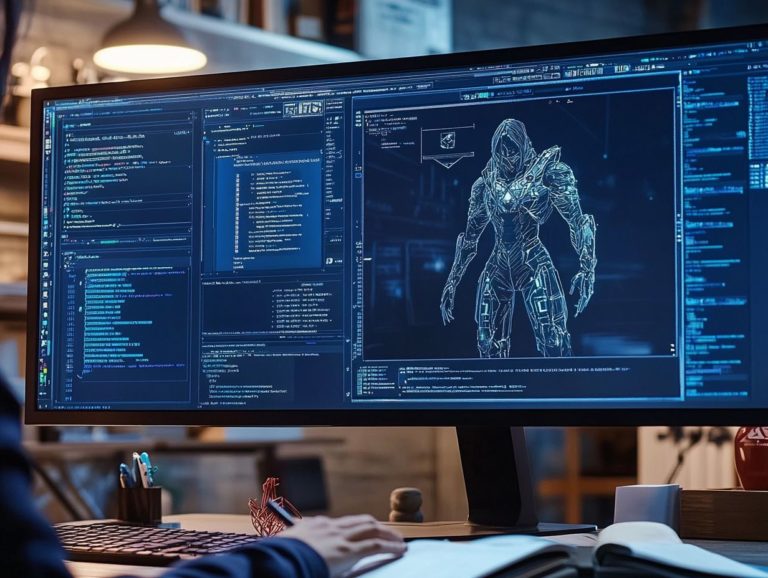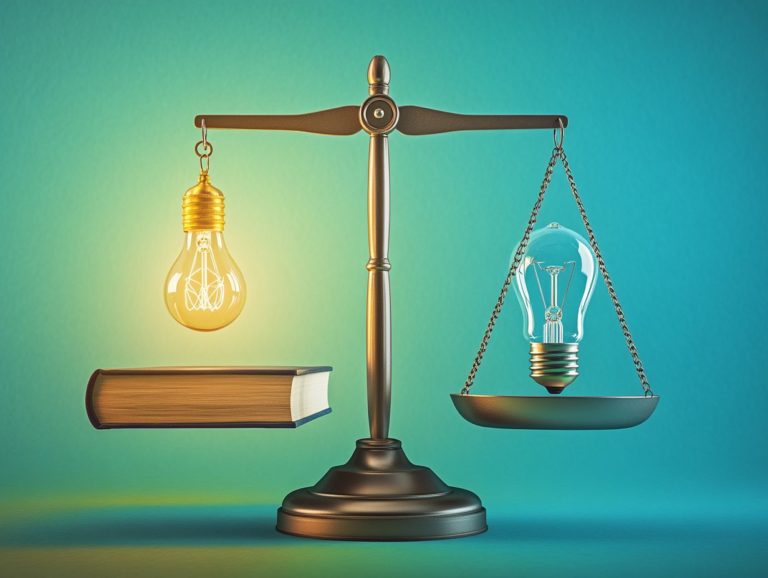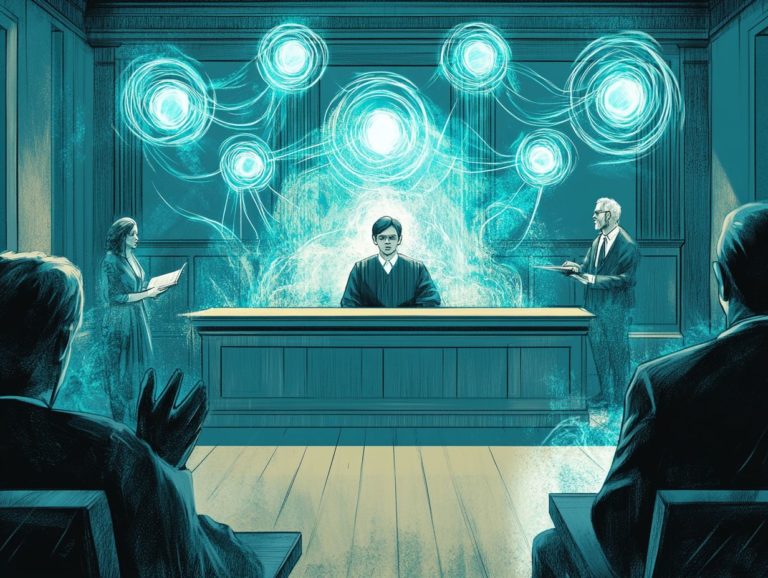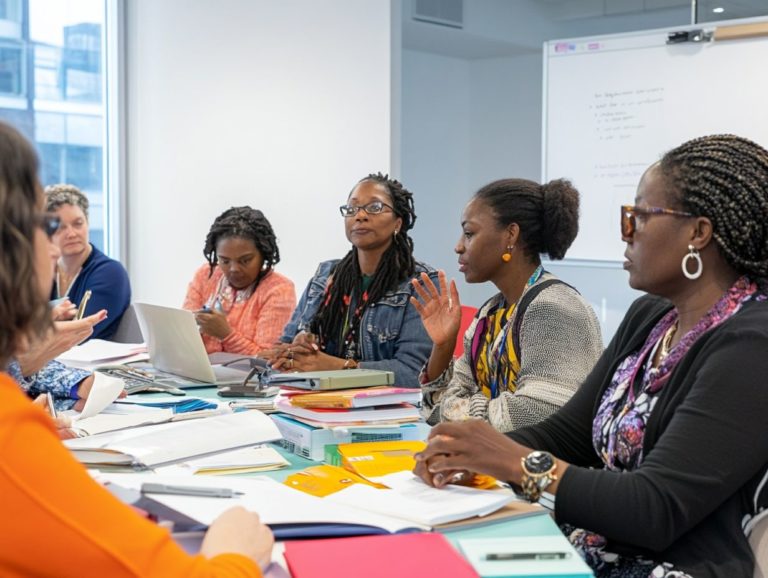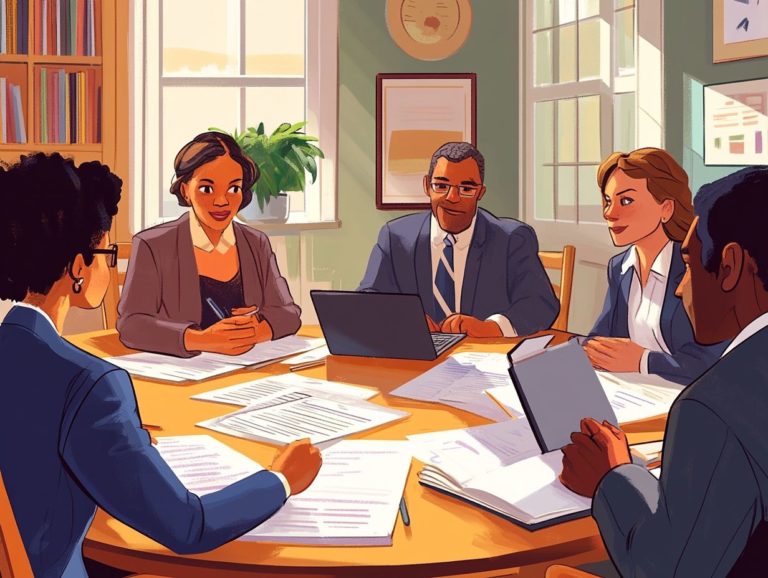5 Common Myths About Copyright Law
Copyright law can feel confusing. Many people are unaware of their rights and responsibilities.
This article aims to clear the fog by debunking five prevalent myths about copyright. It emphasizes that copyright extends far beyond mere creative works, highlights the importance of registration, and unpacks the nuances of fair use.
You ll also delve into the serious implications of copyright infringement. There is practical guidance on how to safeguard your creations. Understanding these aspects is vital for anyone navigating the complex landscape of intellectual property.
Contents
- Key Takeaways:
- 1. Copyright Law Is Only for Creative Works
- 2. Copyright Registration Is Not Necessary
- 3. Giving Credit Is Enough to Avoid Copyright Infringement
- 4. Copyright Infringement Is Only a Civil Offense
- 5. Fair Use Means You Can Use Any Copyrighted Material
- What Is Copyright Law and Why Is It Important?
- What Are the Different Types of Copyrighted Works?
- What Are the Penalties for Copyright Infringement?
- How Can One Protect Themselves from Accidental Copyright Infringement?
- What Are the Common Misconceptions About Copyright Law?
- Frequently Asked Questions
- What are the most common myths about copyright law?
- Is it true that copyright only protects artistic works?
- Do I need to register my work with the copyright office to be protected?
- Can I use copyrighted material if I give credit to the creator?
- Can I modify copyrighted material and use it without permission?
- Does copyrighted material become public domain after a certain time?
Key Takeaways:
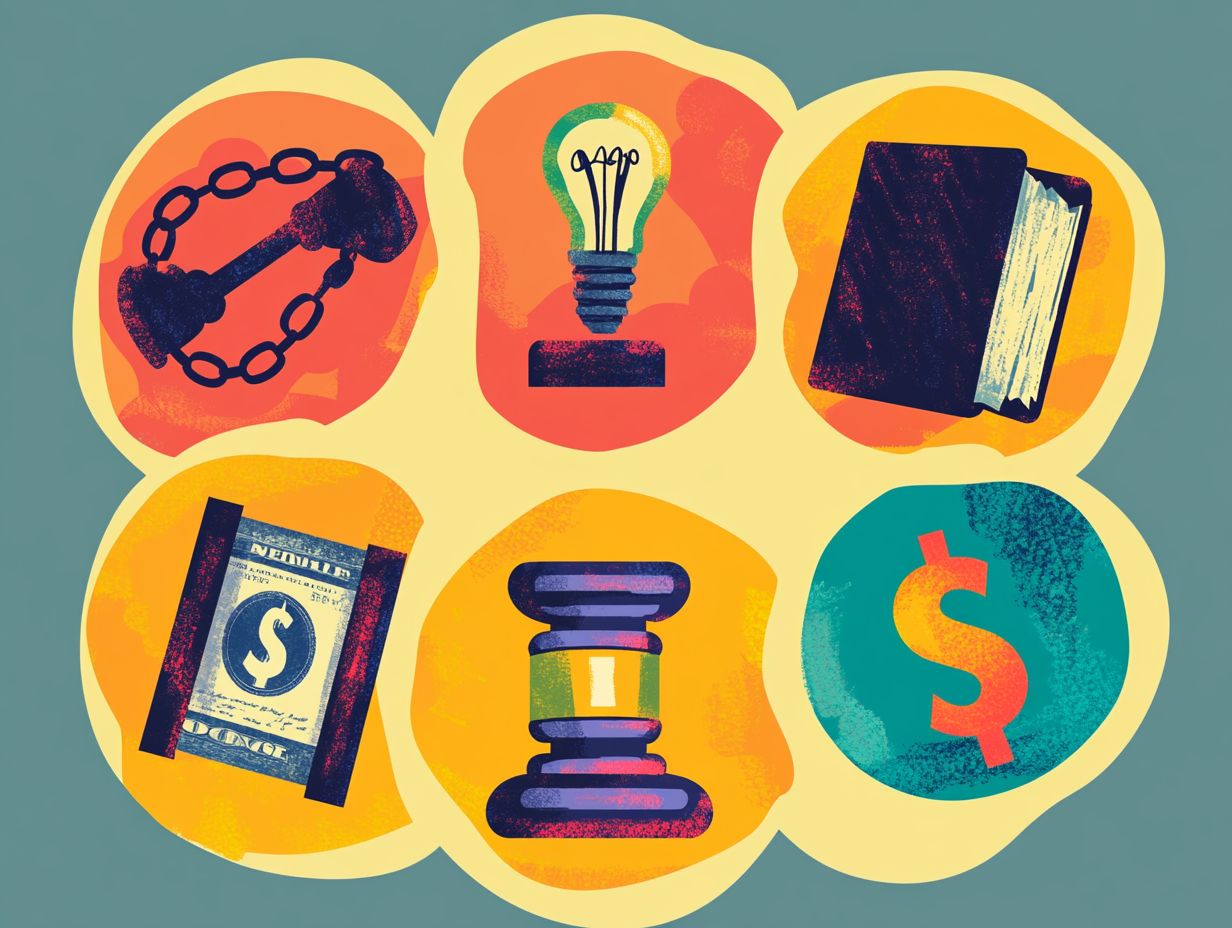
Registering for copyright is not just for creative works, but for all types of original works.
While registering for copyright is not mandatory, it provides additional protection and benefits.
Giving credit is not enough to avoid copyright infringement; permission is needed from the owner.
1. Copyright Law Is Only for Creative Works
Copyright law is often misperceived as applying only to traditional creative works like literature, art, and music. In reality, it covers a broader range of original works, including digital content and works that are based on or inspired by existing works. Additionally, there are many misconceptions surrounding licensing; understanding myths about licensing agreements is crucial for anyone involved in creative industries.
This law establishes essential legal rights for authorship and ownership, whether in tangible or intangible forms. Its flexibility embraces various creative expressions that might not fit neatly into conventional categories, especially in today s dynamic creative landscape.
For example, as a digital photographer, you hold exclusive rights to your images. Filmmakers enjoy protections over their video content, enabling them to legally challenge any unauthorized use or reproduction. Software developers also have significant control over their code, ensuring their innovations remain safe from unauthorized duplication or alteration.
Copyright protections encourage creativity by enabling artists and developers to monetize their work. They also cultivate a culture of respect for intellectual property, ultimately enriching the entire creative ecosystem.
2. Copyright Registration Is Not Necessary
While copyright protection automatically kicks in the moment you create a work in a tangible form, registering that work with the US Copyright Office brings significant advantages. This registration enhances your legal protections and provides remedies in case of infringement claims.
By choosing formal registration, you secure a legal presumption of ownership, invaluable during disputes. Registered works are also eligible for financial compensation set by law, allowing you to pursue financial recourse more easily than trying to prove actual losses afterward.
The registration process is relatively straightforward: fill out a brief application, submit a copy of your work, and pay a fee. It s often less cumbersome than you might anticipate.
A common myth is that formal registration isn t necessary for protection. Without it, your enforcement options may be considerably limited, and proving ownership could become a daunting challenge.
3. Giving Credit Is Enough to Avoid Copyright Infringement
Many people assume that simply giving credit to the original copyright owner is enough to avoid copyright infringement. However, this belief overlooks the intricacies of copyright law, where explicit permission is often necessary. To clarify these misunderstandings, it’s helpful to explore the 5 licensing agreement myths debunked that can shed light on the legal requirements for using someone else’s intellectual property.
While attribution may express respect for the creator s work, it doesn t hold weight in a court of law regarding copyright compliance. For instance, using a snippet of a song in your YouTube video without obtaining the necessary rights can lead to legal trouble, regardless of how much credit you give the artist.
This distinction highlights the crucial difference between fair use where certain conditions might permit limited use without permission and outright infringement, which can incur significant penalties.
Thus, understanding these nuances is vital for anyone working with creative content. Relying on blanket assumptions about proper attribution can easily lead to unintentional violations, as highlighted in 5 uncommon copyright cases you should know.
4. Copyright Infringement Is Only a Civil Offense
While copyright infringement is primarily a civil matter, it carries serious consequences that could lead to criminal penalties under certain circumstances. It s essential to understand your legal rights as a copyright holder and the risks associated with unauthorized use of your works.
The financial implications can be substantial. Civil lawsuits may demand significant compensation for damages, with statutory damages fixed amounts set by law ranging from hundreds to thousands of dollars. This can seriously strain an infringer’s wallet!
In more serious cases, you might even face criminal charges, especially if willful infringement is proven or if it s part of a broader scheme. Copyright holders play a vital role in enforcing their rights; they often monitor unauthorized use and take necessary action to protect their creations.
Understanding copyright protections is crucial not just for creators like you, but also for consumers. It helps mitigate potential legal risks stemming from misuse. Additionally, it’s important to be aware of common myths about trademarks. Dive deeper into this topic to protect your creative work!
5. Fair Use Means You Can Use Any Copyrighted Material
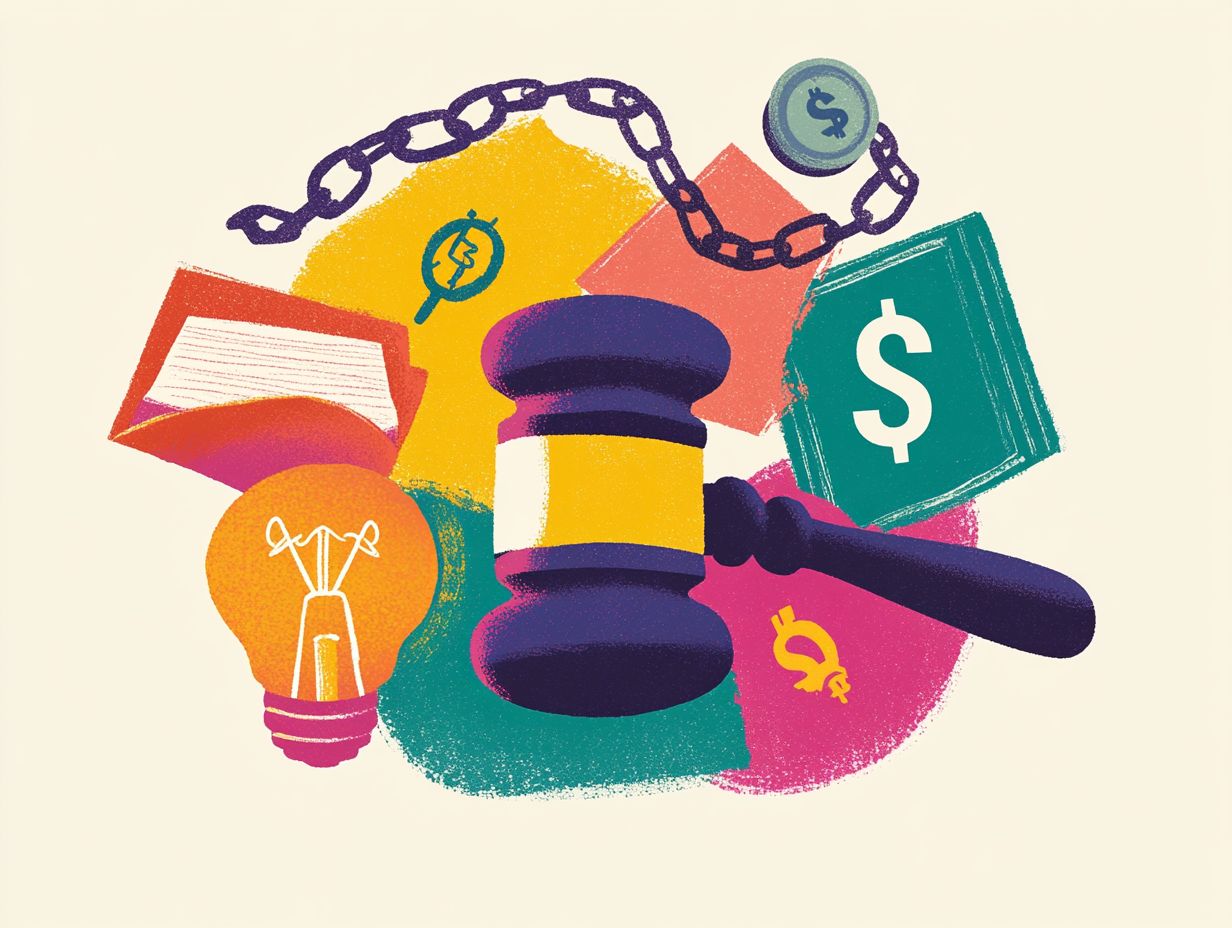
The concept of fair use is often misunderstood as a free pass to use any copyrighted material. However, it s actually a complex legal rule that requires you to analyze each situation individually to determine if your use of copyrighted works whether for education, commentary, or criticism is appropriate.
This doctrine is guided by specific limitations and conditions designed to balance the interests of copyright owners with those of the public. You might invoke fair use when quoting a brief excerpt from a book in a scholarly article or when crafting a parody that humorously comments on the original work.
The transformative nature of your new work plays a crucial role in these assessments. Your intention behind its use matters too. A noncommercial project, like a nonprofit educational video featuring short clips from various films, typically falls within the realm of fair use. In contrast, a commercial venture that leans heavily on someone else’s work may not enjoy the same leniency.
Understanding these distinctions helps clarify the boundaries within which fair use operates. This knowledge allows you to navigate the landscape of copyright with greater confidence.
What Is Copyright Law and Why Is It Important?
Copyright law is an essential pillar of intellectual property that grants you exclusive rights to your original works. Its primary goal is to protect your legal rights while fostering creativity and innovation through clearly defined protections.
This legal framework spans various creative pursuits, from literature and music to art and software, ensuring that your hard work and talent are shielded against unauthorized use.
By outlining the rights and limitations related to these original creations, copyright law enables you to enjoy the financial benefits of your efforts. It also plays a crucial role in maintaining a vibrant marketplace where innovation can thrive.
Ultimately, this legal system acts as a catalyst for diverse artistic expression, encouraging you to create and share your unique contributions without the looming fear of infringement.
What Are the Different Types of Copyrighted Works?
- Literary Works: Includes novels and poetry, expressing ideas beautifully in written form.
- Music: Spans intricate compositions to recorded performances, capturing emotion and creativity.
- Visual Art: Encompasses paintings and sculptures, showcasing unique aesthetic expressions.
- Films: Weave together storytelling, visuals, and sound, crafting immersive experiences that engage the audience.
- Software: Comprises coded instructions that enable computers to execute tasks, reflecting remarkable innovation and creativity.
- Derivative Works: Adaptations or remixes, protected under copyright as long as they meaningfully transform the original content.
Stay informed and protect your creative rights today!
How Does Copyright Registration Protect Your Work?
Copyright registration is an essential tool for protecting your creative work. It provides a public record that solidifies your status as a copyright holder and enhances your ability to enforce protections against infringement claims.
When you register your work with the US Copyright Office, you gain significant legal advantages crucial in disputes. This process establishes a clear chain of ownership and acts as compelling evidence in court, simplifying the task of proving your rights.
As a registered copyright holder, you can pursue specific financial compensation set by law and attorney fees if infringement occurs. This important benefit should not be overlooked by individuals or businesses.
Keeping accurate copyright records is essential. It allows you to track your rights effectively and respond swiftly to any unauthorized uses, safeguarding your creative investments over time.
What Are the Consequences of Copyright Infringement?
The consequences of copyright infringement can be severe, ranging from monetary damages and legal fees to a significant loss of reputation. As a copyright holder, you must protect your rights and understand the risks associated with unauthorized use of your work.
Infringements can result in civil and criminal penalties, highlighting the legal system s commitment to safeguarding creators. For example, a well-known music producer faced substantial fines and jail time for sampling another artist’s work without permission. This not only drained financial resources but also left a lasting stain on the producer’s reputation.
Businesses using copyrighted content without proper licensing may face lawsuits, leading to costly settlements or court orders to halt operations. Understanding these potential repercussions is essential for anyone involved in creative work.
Following copyright rules not only secures your work but also nurtures a culture of respect within the creative community.
How Can One Determine If Fair Use Applies to Their Use of Copyrighted Material?
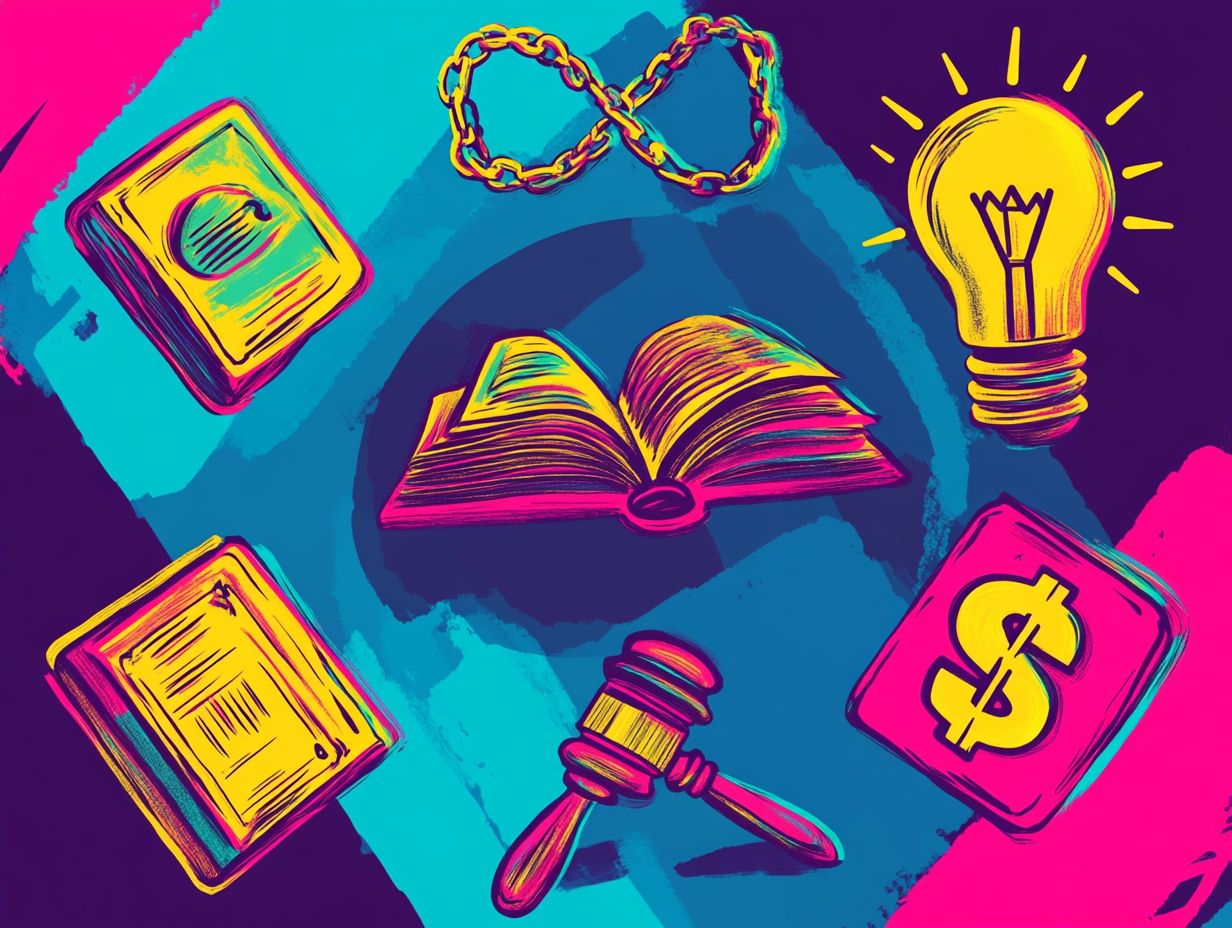
Determining whether fair use applies to your use of copyrighted material requires a thoughtful examination of specific guidelines. Evaluate factors like the purpose of your use, the nature of the copyrighted work, and the amount utilized. Often, this involves transforming the original work for educational purposes or criticism.
For instance, imagine a teacher weaving snippets of a popular film into a lesson on cinematic techniques. This approach could be considered fair use, as the educational intent is clear.
On the flip side, if an artist samples a small portion of a track for a remix, it might also qualify as fair use provided it adds new meaning or a different message and doesn t directly compete with the original.
However, pitfalls often arise when individuals overlook these nuances. Many assume that simply quoting or using a brief excerpt is automatically acceptable, failing to evaluate how their use aligns with fair use criteria. This oversight can lead to unintended copyright infringements, which is the last thing anyone wants.
What Are the Steps to Take If You Believe Someone Has Infringed on Your Copyright?
If you suspect someone has infringed upon your copyright, it s vital to act swiftly to protect your legal rights. Start by documenting the infringement and informing the copyright holder of the potential violation.
First, gather all relevant evidence screenshots, URLs, and dates that will help substantiate your claim. Once you have this information, consider sending a cease-and-desist letter to the infringing party. In that letter, clearly outline your rights and request that they stop their infringing actions.
It s wise to consult legal resources or an attorney to fully understand the protections your copyright provides. Depending on the severity of the infringement, options like mediation or filing a lawsuit may also be available.
Understanding copyright protections is essential throughout this process. This knowledge enables you to make informed decisions and effectively safeguard your creative works.
Don t wait! Protect your creative work today!
What Are the Penalties for Copyright Infringement?
Penalties for copyright infringement can fluctuate significantly. They encompass both civil and criminal repercussions that profoundly impact your legal rights and financial standing.
As a copyright holder, you may encounter various consequences based on the severity of the infringement and the intent behind it. This could mean facing hefty monetary fines and, in certain circumstances, even imprisonment.
Understanding these penalties is essential to deter future violations and deliver justice for creators and artists who invest their time and resources into their work.
Civil penalties often include statutory damages, which can range from a few hundred to thousands of dollars per infringement, even when actual damages are elusive. For example, in the landmark case of Capitol Records, LLC v. Thomas-Rasset, the defendant was ordered to pay an astonishing $1.92 million for the unauthorized sharing of just 24 songs.
Actual damages might address lost profits or licensing revenues, capturing the true financial ramifications of the infringement. In more egregious cases, criminal charges can lead to severe fines and jail time, particularly when willful infringement for commercial gain is involved.
A compelling example is United States v. Boucher, where the defendant faced imprisonment for illegally distributing copyrighted software. These cases vividly illustrate the extensive range of penalties and their profound implications for individuals and businesses alike.
How Can One Protect Themselves from Accidental Copyright Infringement?
Understanding copyright law is essential to protect your creative work. It’s crucial to obtain permission when using others’ intellectual property, especially in educational settings. Additionally, knowing the common myths about patents can further enhance your understanding of intellectual property rights.
This understanding goes beyond mere compliance; it cultivates genuine respect for creativity and innovation. Research the copyright status of any material you plan to use to know whether it falls under fair use, is protected, or resides in the public domain.
Seeking permission from rights holders can significantly reduce risks and pave the way for fruitful collaboration. Utilizing public domain resources is another smart strategy, as these materials are free to use and share.
However, stay attuned to the evolving landscape of copyright protections. By prioritizing these practices and understanding the 5 essential copyright questions, you not only remain within legal boundaries but also contribute to a culture that respects and values creators.
What Are the Common Misconceptions About Copyright Law?
Numerous misconceptions and myths surround copyright law, often leading to misunderstandings about ownership rights and the details of fair use. For example, 5 myths about IP strategy can inadvertently result in copyright infringement.
For instance, you might believe that simply posting content online grants you the freedom to use it as you wish or that citing a source automatically qualifies as fair use. However, there are many misconceptions about intellectual property, including 5 common myths about trade secrets. These assumptions can create pitfalls for anyone who doesn’t fully grasp their rights.
It s vital, as a content creator, to familiarize yourself with copyright law, particularly regarding how protections apply to digital media. By doing so, you can ensure that you respect the rights of others while confidently navigating your own creative endeavors.
Frequently Asked Questions

What are the most common myths about copyright law?
Some of the most common myths include the “poor man’s copyright,” the belief that you can use any images found on the internet for personal use, and the idea that giving credit to the creator is enough to avoid copyright infringement. To learn more about these misconceptions, check out 5 things you didn’t know about copyright law.
Is it true that copyright only protects artistic works?
No, copyright law protects a wide range of works, including literary, musical, dramatic, and visual works, as well as software, architectural designs, and more.
Do I need to register my work with the copyright office to be protected?
No, copyright protection is automatic as soon as a work is created and fixed in a tangible form. However, registering your work with the copyright office can provide additional legal benefits.
Stay informed and protect your creative rights!
Can I use copyrighted material if I give credit to the creator?
No, giving credit doesn’t mean you can use copyrighted material. You need to get permission from the copyright holder or check if your use qualifies as fair use, which is a legal doctrine that allows limited use of copyrighted material without permission under certain circumstances.
Can I modify copyrighted material and use it without permission?
No, changing the material does not grant you permission to use it. You still need to seek permission or verify if your use is considered fair use.
Does copyrighted material become public domain after a certain time?
No, the duration of copyright protection differs based on the type of work and its creation date. In many cases, copyright lasts for the creator’s life plus 70 years or even longer.

